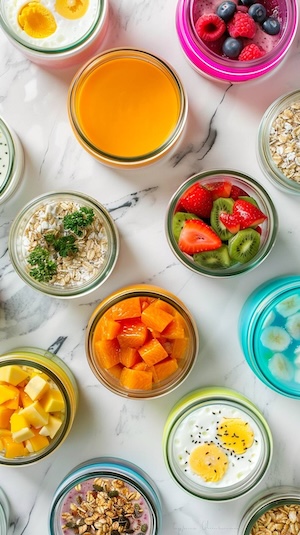Best Cereal for PCOS: Brands Ranked & Reviewed
Discover the best cereal for PCOS with our expert rankings. Compare brands, check ingredients, and find PCOS friendly cereal that supports hormonal balance.
Recipe by /contributors/joanne-chang Editor's note: Use this recipe to make Joanne Chang's Breakfast Pizzas .
Transform your health with tailored 7-day meal plans designed specifically for PCOS management. Just $7/month or $59/year.
Get it now →2 1/4 cups/315 g all-purpose flour
2 1/4 cups/340 g bread flour
3 1/4 tsp active dry yeast, or 1 oz/30 g fresh cake yeast
1/3 cup plus 1 tbsp/80 g granulated sugar
1 tbsp kosher salt
5 large eggs, plus 1 large egg for the egg wash if making loaves
1 cup plus 6 tbsp/310 g unsalted butter, at room temperature, cut into 10 to 12 pieces
Special equipment: stand mixer with dough hook attachment, two 9-by-5-in/23-by-12-cm loaf pans if making loaves, parchment paper if making loaves (optional)
Using the stand mixer, combine the all-purpose flour, bread flour, yeast, sugar, salt, 5 eggs, and 1 ⁄2 cup/120 ml water and beat on low speed for 3 to 4 minutes, or until all of the ingredients have come together. Stop the mixer as needed to scrape the sides and bottom of the bowl to make sure all of the flour has been incorporated into the wet ingredients. Once the dough has come together, beat on low speed for 3 to 4 minutes longer. The dough will be stiff and seem quite dry.
Still on low speed, add the butter, one piece at a time, mixing after each addition until it disappears into the dough. After all of the butter has been added, continue mixing on low speed, stopping the mixer occasionally to scrape the sides and bottom of the bowl, for about 10 minutes. It is important to mix all of the butter thoroughly into the dough. If necessary, break up the dough with your hands to help incorporate the butter.
Once the butter has been completely incorporated, increase the mixer speed to medium and beat for another 15 minutes, or until the dough becomes sticky, soft, and somewhat shiny. It will take some time for it to come together; it will look very shaggy and questionable at the start but in time will turn smooth and silky. When that happens, increase the speed to medium-high and beat for about 1 minute. You should hear the dough make a slap-slap-slap sound as it hits the sides of the bowl. Test the dough by pulling at it; it should stretch a bit and have a little give. (If it seems wet and loose and more like a batter than a dough, add 2 to 3 tbsp flour and mix until it comes together.) If it breaks off into pieces when you pull at it, continue to mix on medium speed for another 2 to 3 minutes, or until it develops more strength and stretches when you grab it. It is ready when you can gather it all together and pick it up in one piece.
Transfer the dough to a large bowl or plastic container and cover it with plastic wrap, pressing the wrap directly onto the surface of the dough. Let the dough proof (that is, expand and develop flavor) in the refrigerator for at least 6 hours or up to overnight. (At this point the dough may be frozen in an airtight container for up to 1 week. Thaw overnight in the refrigerator before using.) If you are making a brioche treat, proceed as directed in the individual recipe.
Line the bottom and sides of the loaf pans with parchment paper, or butter the pans liberally.
Divide the dough in half, and press each half into about a 9-in/23-cm square. (The dough will feel like cold, clammy Play-Doh.) Facing the square, fold down the top one-third toward you, and then fold up the bottom one-third, as if folding a business letter. Press to join the three layers. Turn the folded dough over and place it, seam-side down, into one of the prepared pans. Repeat with the second piece of dough, placing it in the second prepared pan.
Cover the loaves lightly with plastic wrap and place in a warm (78 ° to 82 °F/25 ° to 27 °C) area to proof for 4 to 5 hours, or until the loaves have nearly doubled in size. They should have risen to the rim of the pan and have a rounded top. When you poke at the dough, it should feel soft, pillowy, and light, as if it were filled with air—because it is! The loaves have finished proofing and are filled with yeast air pockets. At this point, the texture of the loaves always reminds me a bit of how it feels to touch a water balloon.
Preheat the oven to 350 °F/180 °C, and place a rack in the center of the oven.
In a small bowl, whisk the remaining egg until blended. Gently brush the tops of the loaves with the beaten egg. Bake for 35 to 45 minutes, or until the tops and sides of the loaves are completely golden brown. Let cool in the pans on wire racks for 30 minutes, then turn the loaves out of the pans and serve warm or continue to cool on the racks. The bread can be stored tightly wrapped in plastic wrap at room temperature for up to 3 days (if it is older than 3 days, try toasting it) or in the freezer for up to 1 month.

You know the drill: Alarm goes off. You hit snooze. Rush around frantically. Skip breakfast AGAIN because there's no time. By 10am, you're hangry, your blood sugar is all over the place, and your PCOS symptoms are already acting up.
Sound familiar?
Finally – a meal prep system designed specifically for women with PCOS who refuse to let chaotic mornings derail their health goals.
In just ONE hour on Sunday, you can transform your entire week:
"I went from skipping breakfast 4 days a week to having delicious, hormone-supporting meals ready every morning. My energy is more stable and my cravings have disappeared!"
– Sarah M.
Stop letting chaotic mornings control your health.
Get your hormone-happy mornings starting this Sunday.
→ Get Your 60-Minute Solution Now
Transform your health with tailored 7-day meal plans designed specifically for PCOS management. Just $7/month or $59/year.
Get it now →Serving Size: 0
| Amount Per ONE Serving | ||
|---|---|---|
| Calories 0 kcal | ||
| Fat 0 g | ||
| Carbohydrate 0 g | ||
| Protein 0 g | ||
💡 Introducing the 10/10 PCOS Solution:
Ten Delicious Crockpot Recipes that take just 10 minutes to prep!
Say goodbye to hours in the kitchen and hello to clean, PCOS-friendly meals made effortlessly.
👉 Click here to grab your 10/10 PCOS Solution today! Try The 10/10 PCOS Solution: Ten Crockpot Recipes That Take Just Ten Minutes to Prep
Managing PCOS can be challenging, but you don't have to do it alone. Join our supportive community to connect with others who understand what you're going through, share tips, and get encouragement. Here's how you can get involved:
Subscribe to our Newsletter: Receive PCOS-friendly recipes, tips, research updates, and more delivered straight to your inbox. Stay informed and empowered with the latest information and support.
Join our Telegram Channel: Stay updated with the latest tips and advice on managing PCOS.
Follow PCOS Meal Planner on Facebook: Engage with our community, participate in discussions, and get support from others.
Break the cycle with the PCOS Meal Planner - your personalized guide to eating better, feeling better, and managing PCOS symptoms. Take control today!

Forget the frustrating cycle of weight loss attempts, endless medications, and living in discomfort. Introducing the PCOS Meal Planner. A meal planning guide that goes beyond temporary fixes to offer a comprehensive strategy, empowering you to ignite a transformation towards lasting health and happiness. Step into a world where you control your PCOS, not the other way around.
Unlock Your PCOS Freedom Now.
Discover the best cereal for PCOS with our expert rankings. Compare brands, check ingredients, and find PCOS friendly cereal that supports hormonal balance.
Learn how to transition away from fruit when starting a ketogenic diet for PCOS. Discover gradual strategies, fruit alternatives, and practical tips for success.
Discover 5 delicious PCOS banana bread recipes with low-glycemic ingredients. Learn how to make hormone-friendly banana bread that supports blood sugar balance.
Creatine for women with PCOS explained simply. Learn safety, benefits, hormone effects, tips, and how creatine may support PCOS symptoms naturally.
Complete PCOS diet plan with foods to eat, foods to avoid, meal timing, and real results. Learn the science-backed approach to managing PCOS through diet, with 7-day meal plan, grocery list, and step-by-step implementation guide. Based on clinical research and real patient outcomes.
Complete guide to ordering at Wendy's with PCOS. Discover the best protein-focused meals, what to skip, and how to customize orders to keep blood sugar stable. Learn which burgers, salads, and sides work for PCOS, plus complete macros for every menu item and smart swaps to avoid insulin spikes.
Complete guide to ordering at Burger King with PCOS. Discover the best protein-focused meals, what to skip, and how to customize orders to keep blood sugar stable. Learn which burgers, salads, and sides work for PCOS, plus complete macros for every menu item and smart swaps to avoid insulin spikes.
Discover 30+ delicious PCOS-friendly smoothie recipes that stabilize blood sugar and support hormones. Each recipe includes protein macros, glycemic load, and hormone-balancing ingredients. Find breakfast smoothies, post-workout options, green smoothies, and dessert alternatives - all designed to prevent insulin spikes while satisfying cravings.
Discover the best supplements for PCOS backed by clinical research. Learn which supplements improve insulin resistance, reduce androgens, support ovulation, and balance hormones. Complete guide with dosages, timing, brands, and what to avoid. Evidence-based recommendations for inositol, vitamin D, omega-3, berberine, and more.